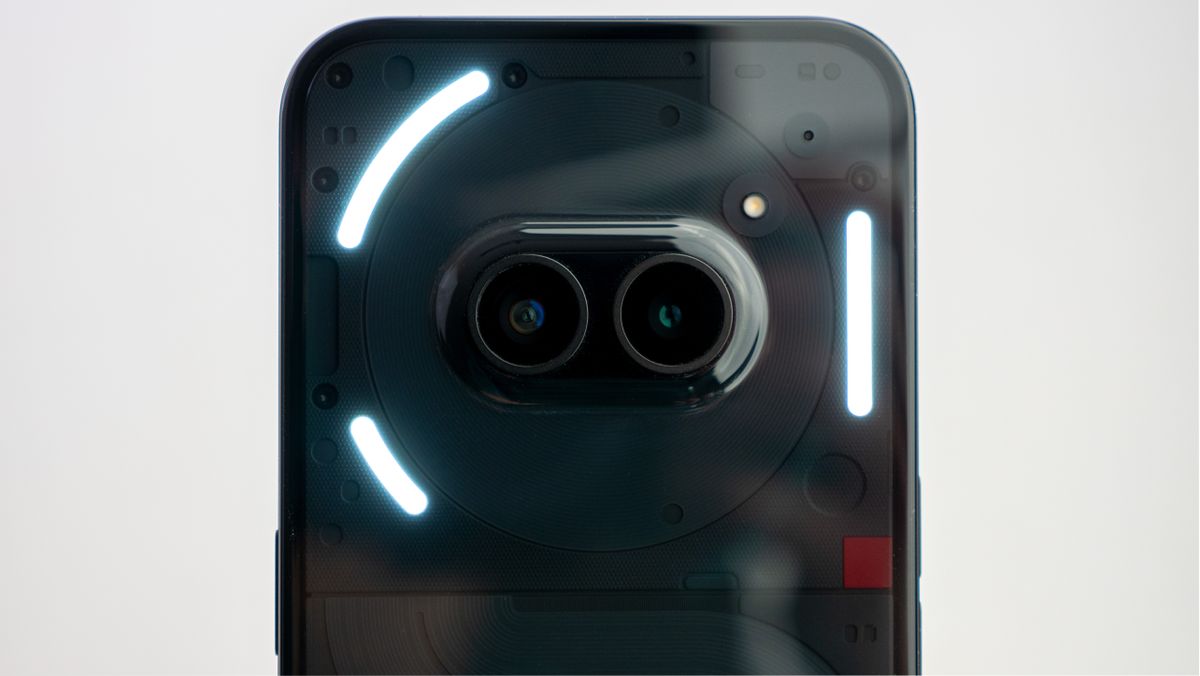The 32MP selfie camera is twice the resolution of the Nothing Phone 1, and the MediaTek Dimensity 7200 Pro processor inside is nearly 20% faster than the Snapdragon 778G+ in that phone, all while retailing for far less. This is a budget phone that’s actually good for gaming, and I had no problems playing anything I tried on the device.
Swipe to scroll horizontally
Nothing Phone (2a) specs
Nothing Phone 2a
Specs
Processor
Mediatek Dimensity 7200 Pro
Display
6.7-inch Flexible AMOLED with Gorilla Glass 5
Display specs
30-120Hz, 1,300 nit peak brightness, 2,160Hz PWM
Camera 1
50MP Samsung GN9, f/1.88, 1/1.56-inch, OIS, PDAF
Camera 2
50MP Samsung JN1, 114-degree FoV
Front camera
32MP Sony IMX615
Battery
5,000mAh, 45W wired charging
Connectivity
5G, Wi-Fi 6e, Bluetooth, NFC
IP rating
IP54
Size
161.74 mm x 76.32 mm x 8.55 mm
Weight
190g
Colors
White, Milk, Black
Starting Price
$349/£319/₹23,999
The company outfitted the Nothing Phone 2a with a fully polycarbonate chassis — even the aluminum side rails are coated in a grippy polycarbonate resin — and it’s both light and durable because of it. It certainly feels “cheaper” than the Nothing Phone 2, but that shouldn’t be a surprise, given that it’s nearly half the price.
Nothing even went so far as to use 100% recycled aluminum, tin, and copper throughout the phone. Plus, I was told that scrap material from Nothing Ear 2 production was used to ensure less waste and a lower carbon footprint for the new device.
Image 1 of 5
(Image credit: Nicholas Sutrich / Android Central)
(Image credit: Nicholas Sutrich / Android Central)
(Image credit: Nicholas Sutrich / Android Central)
(Image credit: Nicholas Sutrich / Android Central)
(Image credit: Nicholas Sutrich / Android Central)
The glyph interface is back and has been refined, offering three different LED strips on the top half of the phone surrounding the unique camera lens configuration. I’ll say the white model looks a lot more attractive than the black model because of the curvature of the glass around the lenses, which was designed to help protect the camera and offer a bit of style.
The display’s 2,160Hz PWM dimming mode kicks in below 50% brightness. Above that level, you’ll find it uses DC-like dimming for a more eye-friendly experience. That’s excellent news for PWM-sensitive folks, but no surprise given that Nothing’s phones have been on our list of best phones for PWM-sensitive people since we began keeping tally.
This isn’t the most comfortable display I’ve used lately, but it’s still better than displays that use PWM at all brightness levels — better than all Samsung and Pixel phones, in other words.
(Image credit: Nicholas Sutrich / Android Central)
The one hold-up is the phone’s availability. Open sales start on March 5 in the UK and India and the phone comes in three colorways: White, Milk, and Black. You can only get the pure white version on the Nothing.tech website, though, so plan accordingly.
One model ships with 8GB RAM and 128GB storage for £319/₹23,999, and users can opt for a model including 12GB RAM and 256GB storage for £349/₹27,999. Folks in India can get a special middle-priced model for ₹25,999 which includes 8GB RAM and 256GB storage.
Open sales are only available in India and the UK.
But U.S. users can only buy the Nothing Phone 2a by signing up for the company’s Developer Program , where a $349 model with 12GB RAM and 256GB storage in the black colorway can be had. Nothing will release the white model after a week, but there’s no mention of open sales for “regular” users in the future.
Image 1 of 3
(Image credit: Nicholas Sutrich / Android Central)
(Image credit: Nicholas Sutrich / Android Central)
(Image credit: Nicholas Sutrich / Android Central)
Nothing has a fantastic budget phone on its hands here that could easily top the list of best cheap phones, but it’s hard to recommend something that can only be purchased if you have to sign up as a developer.
Nothing’s play here is the hope that this will spur the development of apps using the company’s unique Glyph Interface on the back of each of its phones. Given that so many popular apps are developed in the U.S., it makes sense for Nothing to target the country for active development, but I wonder how this will play into the U.K. company’s long-term strategy of Westward expansion.
My guess is that this Nothing Phone 2a will be quickly forgotten here, while it’ll likely do quite well in the U.K. and India. It’s just a shame that yet another affordable phone from a company not named Samsung or Apple evades the grip of most users here.

